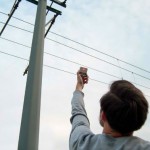Dr. Adrian Smith, an Assistant Professor at North Carolina State, has shared an incredible slow-motion video on his YouTube channel Ant Lab that showcases various insects taking off for flight at 3,200 frames per second (fps) with a Phantom Miro LC321s.
To keep the video interesting, Smith opted to record ‘the weird stuff.’ In other words, rather than bees, house flies and more common insects, Smith chose less-photographed bugs. Specifically, the video covers (in order): plume moth, firefly, painted lichen moth, leafroller moth, rosy maple moth, common stonefly, mayflies, fishflies, aphid, scorpionfly and lacewing.
In addition to the incredible visuals throughout the eight-and-a-half minute video, Smith also shares facts about insect flight and discusses the different flying mechanisms different insects use. Smith also shared the following tweet showing off what gear he used to capture this video.
If you’re curious here’s 100% of the gear I used to film this:
1-phantom miro LC321s; 2- @laowa_lens 60mm 2:1; 3-cheap LED (background light); 4-roscolux #116 (background); 5-focusing rack; 6-cup & acrylic platform; 7-expensive & super bright LED (subject light); 8-magic arm https://t.co/1FqPvpeoMK pic.twitter.com/gRNrYxI8od— Adrian Smith (@DrAdrianSmith) August 21, 2020
You can find more insect videos from Smith on his Ant Lab YouTube channel and follow him on Twitter.
Articles: Digital Photography Review (dpreview.com)












You must be logged in to post a comment.